Patrician IV: Review
by Samuel
|
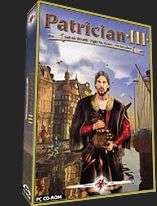 About six years ago I was rooting around in the increasingly shrinking PC section of my nearest GAME store, searching for the rare truffles occasionally obscured behind the accumulated dross of the discounted titles shelf, when I came across a game that I had never heard of but which had a premise and visual style that gripped my brain in a vice. It’s cover had a very late 80s early 90s feel hand-painted illustration of an affluently dressed man with a neatly trimmed beard, clutching a giant leather bag of what was presumably gold coins rather too casually, and standing in front of a medieval European port complete with period sailing ships. This was something that looked as though it belonged on the large and solid cardboard boxes which computer games came on in my youth, and was entirely anachronistic and out of place gazing back at me from the front of a slim plastic DVD case surrounded by the glossy modern tackiness that passes now for a games store.
About six years ago I was rooting around in the increasingly shrinking PC section of my nearest GAME store, searching for the rare truffles occasionally obscured behind the accumulated dross of the discounted titles shelf, when I came across a game that I had never heard of but which had a premise and visual style that gripped my brain in a vice. It’s cover had a very late 80s early 90s feel hand-painted illustration of an affluently dressed man with a neatly trimmed beard, clutching a giant leather bag of what was presumably gold coins rather too casually, and standing in front of a medieval European port complete with period sailing ships. This was something that looked as though it belonged on the large and solid cardboard boxes which computer games came on in my youth, and was entirely anachronistic and out of place gazing back at me from the front of a slim plastic DVD case surrounded by the glossy modern tackiness that passes now for a games store.
Before I sink once more into the deep and lustful nostalgia I felt looking down at that image at the time, and into a prolonged rant about the loss of the era when PC games had boxes and manuals that were as much art as the software they contained, and which held your attention with their sheer presence on the shelf, that game was Patrician III: Rise of the Hanse. A series of contradictions such as 2D sprites in the screenshots, low technical requirements and a price of five pounds yet the game purportedly being only a year old and designed for Windows XP saw me scuttle cackling from the store grasping my newfound treasure and impatient to get home and install it. I’ve not looked back since, and still play Patrician III to this day.
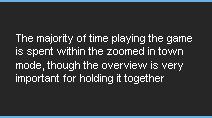 Now, finally, there is a sequel to that game which so vividly caught my attention six years ago. Patrician IV’s arrival is one that I have been anticipating with growing excitement for some months now after finding out about it. Especially as original developer Ascaron went bust last year, leading me to assume at the time that all was over for Patrician and Ascaron’s other cult strategy franchises, most of which I sought out and fell in love with in the wake of discovering Patrician III.
Now, finally, there is a sequel to that game which so vividly caught my attention six years ago. Patrician IV’s arrival is one that I have been anticipating with growing excitement for some months now after finding out about it. Especially as original developer Ascaron went bust last year, leading me to assume at the time that all was over for Patrician and Ascaron’s other cult strategy franchises, most of which I sought out and fell in love with in the wake of discovering Patrician III.
As with previous games in the series, Patrician IV is a strategy and management trading simulator set in the principally Germanic Hanseatic League of the 14th century. Players start with a single small trading ship and a trading office in their chosen home town, and are set the challenge of growing their business and expanding their fleet to span the 24 cities that make up the League and its trading partners in Scandinavia and on the Eastern coast of Britain. As the player’s business interests flourish, so too does their social and political standing in the complex and semi-autonomous society of the Hanse, with the player gradually becoming more embroiled in the political system and running of not only their own interests but of the League itself.
The history of the Hanseatic League probably will not be familiar to many natively English speaking players, being somewhat overlooked by the British school curriculum, but was a major trading and political power in Europe between the 13th and 17th centuries. A series of independent and semi-independent cities and principalities situated in Saxony, Westphalia, Prussia and Flanders, the League dominated trade in the Baltic and North Sea, with outposts and manufacturing facilities reaching as far as Norway, Denmark, Sweden, Britain and even Russia. The Hanse had its own social structure, political set-up, monetary exchange system and laws, and it is this world that the player is immersed into in Patrician IV. Because of the relative obscurity and cultural differences (the sole remaining Hanseatic building in Britain is a warehouse in King’s Lynn, and Hanse settlements in Britain were walled-off enclaves that mostly kept separate from the English and Scottish locals) English speaking players will find a lot in the game that is superficially unfamiliar, though this is actually a plus insofar as it provides a sense of novelty without being too alien.
But enough of that particular history lesson. The game is split into three layers, with an overview of Northern Europe shown as a zoomed out map, the ability to then zoom in on specific towns and cities, and finally a naval combat interface. The majority of time playing the game is spent within the zoomed in town mode, though the overview is very important for holding it together, with players eventually growing their business to encompass more than their home port and the one or two nearest to it, until you’re juggling several trade routes and manufacturing processes right across the whole of Northern Europe.
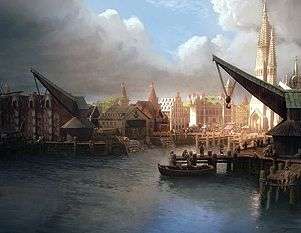 To zoom in on one of the 24 towns dotted around the overview map, you need to either have a trading office or convoy of trading ships present at that location. As trade prices change to suit supply and demand, as part of a very well developed AI which keeps the game fresh and avoids it falling into the trap of becoming overly repetitive (IE trading a single resource, buying it at a low price in the same port and selling it at absurd profit in another same port over and over, as some games in the genre suffer from), the overview hints at the most desired resource or commodity in towns outside of your current sphere of influence by showing a small icon under the town name, allowing you to know roughly what to load your convoy’s holds with before you set sail for a closer look.
To zoom in on one of the 24 towns dotted around the overview map, you need to either have a trading office or convoy of trading ships present at that location. As trade prices change to suit supply and demand, as part of a very well developed AI which keeps the game fresh and avoids it falling into the trap of becoming overly repetitive (IE trading a single resource, buying it at a low price in the same port and selling it at absurd profit in another same port over and over, as some games in the genre suffer from), the overview hints at the most desired resource or commodity in towns outside of your current sphere of influence by showing a small icon under the town name, allowing you to know roughly what to load your convoy’s holds with before you set sail for a closer look.
Inside each town there are a number of buildings, some belonging to the player, and others belonging to the town, of differing function and importance but all of which play an important role at various times, making it crucial to familiarise yourself with all of them. There is the town hall, where the mayor and council sit and conduct official town and Hanse business. The guild hall, where the trade guild holds auctions and keeps track of the player’s achievements as well as those of other players. The local pub, which serves as a hub for any number of things, from hiring sailors to man your ships, to shady under the table deals with criminals and weapons dealers. The shipyards in Hanse cities, and repair docks in trading outposts, which handle such matters as commissioning the construction of new vessels, performing upgrades to your current ships, and repairs to damage incurred either in battle or simply sailing around in winter when storms ravage the seas and icebergs drift about in the most Northerly reaches. The architect’s office where you purchase planning permission to construct anything from new housing for town residents to farms and factories to produce your own merchandise for less than even the most generous purchasing price. Dockside loading cranes and marketplaces where you conduct trade between the town market and your convoys or local warehouse. And there is your trading office, which provides an overview of all your business interests within that town, as well as your overall balance of trade, and which is necessary before you are allowed to build any other buildings in that location.
The final interface, naval combat, is optional. If your convoy is attacked by pirates, or alternately, if you decide to turn pirate yourself in order to prey on other traders, the game offers you a choice between settling the conflict automatically, or taking control of the battle manually. If you elect the manual route, you are taken to an extreme zoomed in view of the sea and the ships involved, and are able to choose which of the enemy ships each of your armed vessels engage, with which arrangement of sails, and which type of ammunition they employ. There are three kinds of ship to ship fire; standard round shot cannon balls for blasting holes in ships hulls, chain shot for wrecking the rigging and cutting away masts in order to disable ships for either capture or an easier kill, and finally grapeshot for slaughtering the enemy ships crew, yielding a variety of advantages. However, regardless of which decisions you make to what kind of shot your ships use, battles are still mostly automated with ships manoeuvring themselves towards and around your selected target, and almost always resulting in the exact same outcome as though you’d automatically resolved the fight in the first place. Altering sail to change speed is virtually useless, as the computer AI always goes at maximum spread, and slowing your ships results in the computer dancing around you and blasting bloody great holes in your ship.
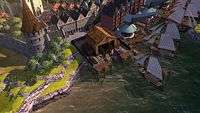 |
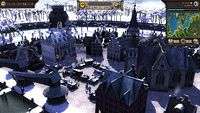 |
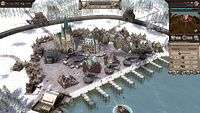 |
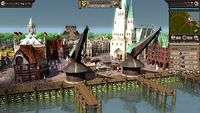 |
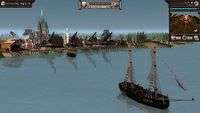 |
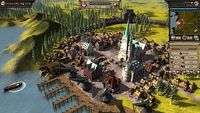 |
There is a campaign mode in single player, but it mostly acts as a kind of glorified tutorial, with a somewhat sketchy story about working for your uncle, before finally breaking out from under his shadow and becoming a respected businessman and politician in your own right. Once the player is familiar with the controls and fundamentals, there’s much more fun to be had going directly over to the sandbox mode, which sees you given a quantity of money and an unarmed ship and left to your own devices. In lieu of the mission objectives that the campaign offers, various random events occur during sandbox play, including pirate raids, offers to smuggle or hide goods, town sieges and famines, outbreaks of plague, and even the option to woo various eligible partners and eventually marry. Marrying comes with certain perks, including your spouse entertaining and influencing councillors and patricians on your behalf, allowing the player to concentrate more on trade than the social and political aspect of the game, and if you are playing as a male trader marrying a woman, her father pays you a dowry, which can include ships and valuable resources as well as cold hard cash. How large the dowry is, as well as how capable your spouse is at managing your political reputation, varies depending on your choice of partner.
Visually the game is very basic, even on the higher settings. The overview is especially simplistic, with no attempt made to hide the basic vector rendering of the map itself and the ship icons sailing about on it. Inside towns and battles the graphics are somewhat better, with fairly detailed textures and decent special effects but generally small and simple objects. It’s all a bit clinical, it does the job but it isn’t very aesthetically pleasing.
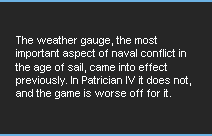 The sounds follow much the same kind of mentality as the graphics, with a generic soundtrack that tends to vary to fit stereotypical styles of music depending on what town you’re viewing; pompous sounding horns for the Germanic towns, and Russian folk dancing type music for Novgorod, for example. British towns have something like a hornpipe, amusingly. It works, as do the sound effects (all of which seem to be identical to the sound effects from Patrician III, which in turn recycled the sounds from Patrician II), but it feels cheap and relatively tacked on as a last minute oversight.
The sounds follow much the same kind of mentality as the graphics, with a generic soundtrack that tends to vary to fit stereotypical styles of music depending on what town you’re viewing; pompous sounding horns for the Germanic towns, and Russian folk dancing type music for Novgorod, for example. British towns have something like a hornpipe, amusingly. It works, as do the sound effects (all of which seem to be identical to the sound effects from Patrician III, which in turn recycled the sounds from Patrician II), but it feels cheap and relatively tacked on as a last minute oversight.
In fact, Patrician IV suffers very badly for something more than looks and recycled sound schemes. Patrician III. For all intents and purposes, Patrician IV is a flawed carbon copy of its predecessor. The obvious intent was to take the successful but aging Patrician III, which was itself simply Patrician II bundled with its expansion pack and translated into English making the game actually a 2000 title despite the English release being in 2003, and make it look like a modern game. This backfires, as the way that the game has been modernised strips out most of the charm, and introduces a whole flotilla of new problems.
Patrician III had a very simple 2D isometric art design, but it was very stylised and colourful and looked right. It was very charming, especially to players who had been gaming since the 80s and early 90s, as the entire design was redolent of that golden era for 2D sprites and pixel art. And the overview map previously was a static image, but it was such a gloriously detailed hand-drawn map in the style of medieval sea charts that it makes the current overview look simply terrible, like the weather forecast chart on a particularly low budget TV channel, or the BBC when computer generated weather reports first kicked off. Clicking on buildings in Patrician III meant that you were always greeted with a smiling avatar of the person you were about to interact or do business with, but that has gone in favour of simple windows full of text.
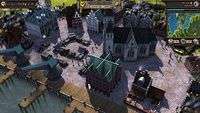 |
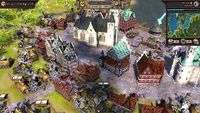 |
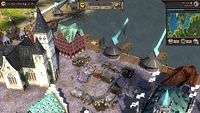 |
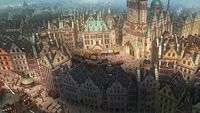 |
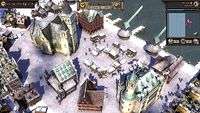 |
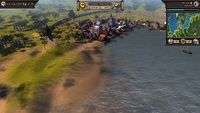 |
Patrician III’s naval battles were more complicated, but much more satisfying and offered much greater control. You manoeuvred your ship manually, rather than selecting a target and the AI taking over, and you had a trigger button to fire your broadside which meant that you could wait and time it to smash the enemy ship at just the right moment to send it to the bottom or weaken it for boarding in a relatively salvageable state. It was possible, through clever control of your ship, to take on much larger and more heavily armed opponents and win, through superior seamanship and tactics. And speed was more naturally dictated by overall damage, and wind speed and direction. The weather gauge, the most important aspect of naval conflict in the age of sail, came into effect previously. In Patrician IV it does not, and the game is worse off for it.
There are other things, too, seemingly minor but which add up. In Patrician III you could rename each of your ships individually, personalising them and also making them easier to identify in a large convoy or crowded harbour. You could also dispatch them singly without their being attached to a convoy; Patrician IV requires your ships to belong to a convoy before they are allowed to set sail, even if you only own the one ship, which seems a ludicrous design oversight, and adds an unnecessary layer of menus for most of the early part of the game. As well, previously all ships with weapons could participate in battles, and now you have to specify warships and cargo vessels. When you only have one ship, this essentially means you have no means of defending yourself.
On top of all that the map editor that came bundled with Patrician III is no more, so you can’t create your own overviews with up to 40 cities, leaving you with only the default 24 and always the same cities in Patrician IV. And network play, another former feature, is missing too. Perhaps it wasn’t possible to provide an online mode, and network play was deemed to be something belonging to the past, certainly, other strategy games have dropped it as well. But there are still those of us who make the effort to have LAN parties.
Pros- A fantastic dynamic economy that evolves in response to events in each game, whether the result of computer opponents or the player.
- Offers English players a rare insight into an often overlooked aspect of European history, even if they may not realise it.
- Addictive gameplay that absorb players to the point that entire days are lost unnoticed playing the sandbox mode.
- Manages to combine trading and business management with social and political manoeuvring in a way that feels natural, with each side of medieval mercantile life complimenting the other rather than one dominating or interfering unduly with the other.
- Serves as an excellent primer for the wider trading management sub-genre; simple to learn the basic fundaments, but challenging to master in the advanced stages.
- It’s a very ugly looking game in places, and feels cheap and rushed.
- Many of the gameplay features work somewhat less ably here than in the game’s immediate predecessor.
- The campaign is relatively weak, and fails to hold interest beyond serving as a glorified tutorial.
- Naval combat has been effectively neutered.
- No map editor.
- No network play mode.
Taken by its own merits, Patrician IV is a decent example of this genre of game. A player coming to the franchise without having played previous entries can find much to enjoy here, unaware that in quite a few respects features have been lost or regressed from Patrician III. It isn’t the best naval trading and management strategy game around, and the few games in direct competition with Patrician IV would have to be said to be better overall experiences; I am thinking here of Anno 1404 and East India Company. Perhaps fortunately for most English gamers, the Patrician series is relatively unknown outside of Germany and the Netherlands, so odds are that someone picking this game up will not have played the previous title.
And it pains me to say that. Patrician III was a fantastic game in its day, way ahead of its time and sadly never really got the attention it deserved despite developing a cult following of very loyal fans as well as critical praise. Ten years ago, Patrician was the more sophisticated game, with Anno 1602 being the young pretender. I personally hold a deep fondness for both franchises, and to see one of them seemingly take several steps backwards is personally upsetting.
I think part of this has to be blamed on the very short development time given to Patrician IV. When the series creator Ascaron stopped, somewhat ironically, trading in 2009 and Kalypso Media stepped in and purchased the license, they almost immediately announced a new sequel and set a date of autumn 2010. This was probably to convince the fans who had stood by Ascaron and Patrician III for so long that Kalypso were taking the franchise seriously. And that was a noble sentiment, but the game suffers from the lack of polish that such a hurried development naturally resulted in. I know for a fact that Kalypso can do better than this; their similar reboot of another cult strategy series of old, Tropico, was utterly fantastic and improved on what made the classic games great in every way. Patrician should have been the same, and it’s such a shame that instead we’re presented with an inferior copy of its forebears.
What I hope will happen is that Patrician IV will still prove enough of a moderate hit by drawing in new players to the series that Kalypso step back and take the time to make Patrician V something really special. I don’t want to see Patrician end here. It could be so much more, and already has been in the past. If this review damages the chances of that, I will not be very proud of myself, but at the same time I have an obligation to existing fans to point out where Patrician IV falls short in comparison to Patrician III.
It’s just baffling, especially as Patrician III has no compatibility issues with Windows Vista or 7 and continues to run perfectly well after simply being installed from the CD, takes up a sixth the space on your hard drive, and is still available for sale for a few pounds. The Impulse downloadable service is offering it for free with every purchase of Patrician IV, ironically.
So... A good game for the uninitiated. But Patrician veterans will likely wonder what went wrong.
Last five articles by Samuel
- Wargame: European Escalation - Preview
- Sony Conference - GamesCom 2011
- Gotham City Impostors Hands-On Preview
- WipEout 2048 - Hands-On Preview
- City to City - Travelling to Cologne via London with Gerry Rafferty















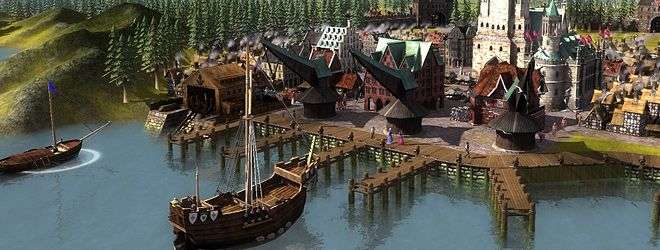

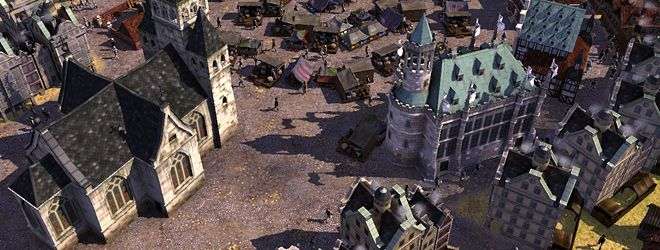





Finally! A game based on the Germanic Hanseatic League of the 14th century!
This game couldn’t be less my cup of tea if it was a cup of bees but the Preach attention to detail always makes for a good read. You got skills, kid.
Detailed review, very interesting stuff. From the screenshots alone, the first time I saw them, I was disappointed…like you, I love the 2D iso charm of the third game, it had a gorgeous level of detail, character, and colour that seems, sadly, to be missing here. While the towns look more realistic, it appears that some of the heart of the visuals had suffered for it. I suppose the lacking naval battles wouldn’t trouble me, since I usually veer down the auto route out of laziness and inexperience, however, having less control than the previous game is rather odd…as is everything that you say has been pared back or unnecessarily altered.
I was, and still am, interested in picking this one up at some point, however, I can still see myself sticking to the third game for the asthetics alone. As a relative newcomer to the series, this one may not be so much of an issue for me, with the various flaws, since I have less invested in the series and less in-depth knowledge of what has been changed, so on my list it will likely go.
This is something that I’m quite interested in… I’ve never played the Patrician games before but my recent obsession with Commander: COTA has rekindled my passion for playing on the PC and getting stuck in to the strategy type games again… so much so that I spent the entire weekend reformatting and reinstalling my old(ish) Qosmio laptop so I could play games in the lounge rather than locking myself away in the gaming room. Patrician IV looks like it has all those little intricacies that I enjoy about gaming – the domino effect so that if you mess up in one area, everything else comes crashing down around you.
I’m convinced. I’m going to have to look at picking this up I reckon, nice one.
Thanks for the comments as always guys. Rich, at this rate, I’m convinced you’re trying to get my head stuck in a doorway heh.
Lorna, I expect the lessened control of naval battles was just simplifying it to make it more accessible to people. I am quite a big nerd about naval combat, I understand Patrick O’Brian novels and when I go sailing I like to pretend my dinghy is a warship from time to time. Though if anyone quotes me on that, I will deny it strenuously. Whilst I spend more time and effort on reading about the 17th century naval conflicts during the Napoleonic and American wars, the basics remain more or less the same. If you hold the weather gauge and can use it skilfully, you’ll win. If you’re really good, you’ll gain the weather gauge from an opponent who had it over you. And on a calm day the man with the biggest boat and the most guns will probably piss it.
The flaws in the interface and the missing features that were in Patrician II and Patrician III I can only put down to the development period they gave themselves. Less than a year. They must have rebuilt everything except the sound effects from scratch, because it’s an entirely new graphics engine and everything, and they just didn’t have the time to do it justice, and it’s a shame. Now that they’ve gotten the series reboot out of the way, ten years after the previous game was originally developed, maybe they’ll take a bit more time and spend the next two or three years making Patrician V utterly fantastic. I hope that’s what happens anyway.
Mark, it is a good game, it’s just not as good as the one it’s following on from, so if you’ve never played the older ones and you’ve only recently got into this sub-genre of strategy I expect you’ll probably have much more fun with it than I could. I couldn’t help seeing the flaws, because I had a basis of comparison in the back of my mind the entire time. In a way I envy your being able to look at this from an entirely fresh perspective. You don’t have years of pent up waiting for this game driving up expectations, so you’ll likely come to an utterly different conclusion about the game to me. I hope you enjoy it. I though have already gone back to Patrician III.
Another great review, Preacher!
Sadly, it’s not a game or genre I’m interested in, and I can’t hold my attention long enough to it to make it stick, sadly.
Bollocks, I said sadly twice in the same sentence. Let’s ignore my cock-up there.
Still, I’m looking forward to seeing more reviews from you in the future, you do an amazing job of writing them with lots of insights and details which make the game interesting to read about even if the game isn’t something I have an interest in.
Complex naval combat is fair enough and of great interest, however, it may be less about dumbing down under the assumption that some people may not know anything about it, and perhaps more about not trying to pull the game in too many directions, which can be a risk, especially with a management game.
That could be, though it all worked previously without overshadowing the other aspects of the game.
[...] Those who like their trading games hardcore should look no further than the German developed Patrician series. Famous for its deep trading system, often unforgiving gameplay, and engaging graphics, the series has been a favoured domain of management fans for a long time, and the recent release of Patrician IV saw the series advance, though it wasn’t without its flaws – see our review for more. [...]